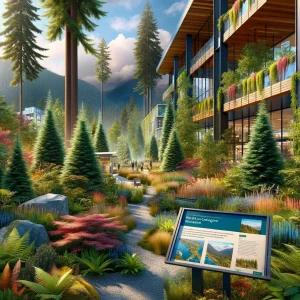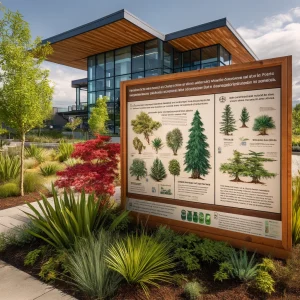In the lush landscapes of British Columbia, businesses find a special chance to embed their brand identity deeply within the local scenery. This guide highlights how incorporating native flora, such as the Pacific Dogwood and Red Cedar, into commercial landscaping transcends mere aesthetics to reflect a company’s dedication to sustainability and community engagement. Explore the transformative power of British Columbia’s native plants to bolster brand identity, underscored by a commitment to environmental benefits and practical integration steps.

The Power of Native Plants in Commercial Landscaping
Native plants like the Pacific Dogwood, Western Red Cedar, and Douglas Fir are more than mere symbols of British Columbia’s natural heritage. Indeed, they embody the resilience, beauty, and diversity of the region, making them perfect ambassadors for any business looking to deepen its local roots. Furthermore, their appeal goes beyond the aesthetic; using native flora in landscaping offers substantial environmental benefits, including supporting local ecosystems, promoting biodiversity, and reducing water use and maintenance requirements compared to non-native species.

Environmental Benefits: A Data-Driven Approach
Incorporating local flora into commercial spaces can significantly impact the local ecosystem. Specifically, studies have shown that landscapes utilizing native plants require less water, fewer pesticides, and minimal care, contributing to a healthier environment. Additionally, native plants are adapted to their local climate, making them more resilient to weather extremes and pests. This resilience translates into lower maintenance costs and a reduced carbon footprint—a compelling argument for businesses aiming for sustainability.
Practical Steps for Integration
Assessment and Planning: Initially, thoroughly assess your current landscaping and identify opportunities to introduce native plants. Consider factors like soil type, sunlight, and water availability. Moreover, consulting with a local expert can provide invaluable insights into selecting the right plants for your site.
Design with Diversity in Mind: Subsequently, design your landscape to mimic the natural diversity of a British Columbia ecosystem. Incorporate a mix of trees, shrubs, and groundcovers to create a layered look that is visually appealing and beneficial to local wildlife.
Highlight Signature Species: Importantly, choose signature native plants that can serve as focal points in your landscaping. For instance, the majestic Western Red Cedar or the striking Pacific Dogwood can anchor your design, making a strong statement about your brand’s connection to the local environment.
Educate and Engage: Furthermore, use your landscaping to educate your customers and employees about the value of native plants and your business’s commitment to environmental stewardship. Interpretive signage or guided tours can add an interactive element to your green space.
Maintenance and Care: Additionally, adopt sustainable maintenance practices to ensure your native plant landscaping thrives. This includes using organic mulches, reducing water usage through drip irrigation, and avoiding chemical pesticides and fertilizers.
Overcoming Challenges
While the benefits of using native plants in commercial landscaping are clear, businesses may face challenges, such as finding suitable plants for their specific site conditions or managing the initial transition period. Overcoming these challenges requires a willingness to experiment, learn, and collaborate with local nurseries and landscaping professionals specializing in native plants.
Leveraging local flora for brand identity is a powerful strategy for businesses in British Columbia that aligns with growing consumer demand for sustainability and authenticity. By integrating native plants into commercial landscaping, companies can beautify their spaces, contribute to the preservation of the local ecosystem, and express their commitment to the community’s well-being. As we look to the future, the thoughtful inclusion of British Columbia’s native flora in commercial landscapes will continue to be a hallmark of environmentally conscious and locally rooted businesses.